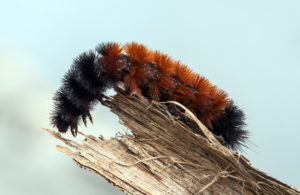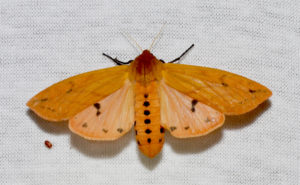
Pyrrharctia isabella Caterpillar -also known as the “wooly worm” Photo: Micha L. Rieser
Despite the fact that it is in the mid-70’s in early November, winter is around the corner. What does winter have in store this year? Some like to think that Mother Nature gives clues in the plants and animals around us. A couple of weeks ago I wrote about looking at persimmon tree seeds as winter weather predictors—but as a few readers pointed out to me on the blog, we can’t forget wooly worms!
Each fall, it’s hard not to notice them—little fuzzy caterpillars crawling across roads, sidewalks, and paths everywhere. Where ever they’re going, they seem very determined. Every year someone asks me what they actually are. Do they stay as they are, or morph into something entirely different in time? And how does a wooly worm forecast the winter weather?
Different species of wooly worms are found all over the world. The ancient Romans used the Latin term catta pilosa, literally “hairy cat” to describe them. The term caterpillar traces back to these early descriptions.
The creatures we call wooly worms are in fact caterpillars, so their time spent as a wooly worm is limited. The U.S. is home to at least eight species of hairy caterpillars that are commonly called wooly worms. In central Illinois we are most familiar with the banded wooly bear (or worm), Pyrrharctia Isabella. Following the pupal stage, the banded wooly bear emerges in its adult form, the Isabella tiger moth.

Isabella Tiger Moth, Pyrrharctia Isabella–larvae is what we call a “wooly worm” Photo: Andy Reago & Chrissy McClarren
Experts estimate around 260 species of tiger moths in North America. Their caterpillars share some degree of hairiness—from a few hairs to being completely covered in hairs, like the wooly worms. Tiger moths get their name from their bright coloration. They are typically some spotted or striped combination of gold and black. Some species also have red, white, and gray colors interspersed as well. The Isabella tiger moth is a dull yellow-orange with some black spotting, and its first pair of legs have bright red-orange segments.
Two generations of banded wooly bears, or Isabella tiger moths are born each year. One typically hatches in May, the other in August. Most people don’t notice wooly worms in the spring and early summer, but they’re around, feeding on various plants and growing.
One reason we probably don’t notice them is that essentially they’re hermits, preferring solitude over socializing. Another tiger moth larva, fall webworm, is far more friendly, and congregates in large populations on their host plants.
It is only in the early autumn that most people notice wooly worms, and they’re usually in a big hurry to get somewhere. What’s the rush? Each wooly worm is scrambling to find a warm nook or cranny in which to overwinter. Unlike other butterflies or moths, the wooly worm spends the winter as a caterpillar, not a pupa or chrysalis. The hairs covering their bodies are thought to offer some degree of insulation from cold winter temperatures.
When the weather warms in the spring, the banded wooly worm becomes active again. They feed for a short time, then pupate and emerge a few weeks later as adult Isabella tiger moths.
There is a lot of folklore surrounding the banded wooly worm, particularly related to its supposed power to predict upcoming winter weather each fall based on it’s physical appearance.
-
- The typical banded wooly worm has sections of black hairs at each end, and a section of orange-brown hairs in the center.
-
- Legend says that the more black on a banded wooly worm, the more severe the winter will be.
-
- Some folks have taken this to an extreme, and noting that there are thirteen segments in a typical banded wooly worm, they argue that each segment represents one week of winter. Orange segments predict mild weeks, and black ones foretell bad winter weather.
-
- Sometimes wooly worms are white—which supposedly predicts an extremely snowy winter when these are seen in high numbers.
-
- Some insist that the thickness of the hairs is the predictor—thick hair equals a bad winter, sparse hair a mild one.
- Another legend says that the direction a wooly worm is found traveling is a hint about the coming winter. If the wooly worm is traveling north, count on a mild winter. If he’s headed south, get ready for a long cold winter.
Local “wooly worm forecasts” that I’ve seen say 2016-17 will be a particularly cold and snowy winter, especially late winter due to the abundance of wooly worms with large black rear segments as well as a larger than usual population of white wooly worms.
Research has shown repeatedly that the colors or hairs of wooly worms have no bearing on weather the following winter. Larvae hatched from the same clutch of eggs reared under one set of environmental conditions will show a range of hair thickness and colorations, from fully orange to fully black. This variation in a constant environment is a strong argument against wooly worms being able to predict the weather.
Despite the scientific evidence that discredits any super weather predicting power of the wooly worm, people are very passionate about their wooly worms. Several towns in the U.S. have their own wooly worm festivals. Banner Elk, North Carolina hosts an annual festival complete with a wooly worm race.
The winner is declared the “official” predictor of winter weather. People come from miles around to participate. Some bring wooly worms they collected themselves, others prefer to buy a wooly worm from one of the “breeders” that brings their best racing stock to the festival.
Whether you believe in the power of the wooly worm forecast or not, it feeds our very human desire to think we can predict the future—and if this winter really is cold and snowy, we may enjoy some bragging rights that we “saw it coming”!
If you liked this post, please subscribe to Grounded and Growing today and receive your copy of “15 Tips to Become a '15 Minute Gardener'” so you can spend less time working ON your garden and more time enjoying being IN your garden.! It’s absolutely free. When you join the Grounded and Growing community, you’ll finally take the garden off your “To-Do” list and allow yourself time to enjoy your garden and savor the peace and serenity there. I tell subscribers about new posts as soon as I hit ‘publish’ and send weekly-ish updates on what’s going on in my garden– good, bad AND ugly.
And if the wooly worm is going in circles? Winter will never end!
LOL! 🙂
Thanks for such detailed information. I didnt know there were so many species of tiger months. Are they really destructive to they host plants, and what are the host plants? Sorry to ask, sometimes its like falling down a rabbit hole with one question leading to another! I’ve been inspired to investigate. Thanks!
Hi Beth, thanks for your comment! Everything I have read on wooly worms says they are generalists when it comes to food, but particularly enjoy herbaceous plants, including vegetable plants. I have had a lot of interesting emails over the years, and I’ll never forget one lady who was rearing a wooly worm in an aquarium, feeding it spinach.
I’ve never once had anyone complain to me about wooly worm damage. Unlike some other larvae and insects, the wooly worm is solitary, so any damage it does to a plant is likely to go unnoticed.